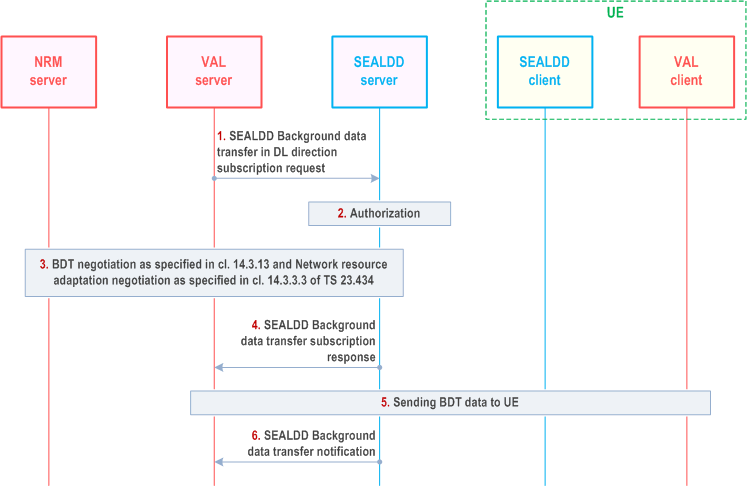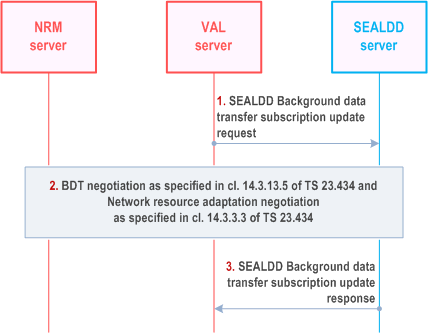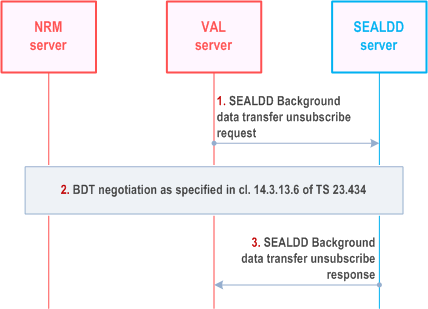Content for TS 23.433 Word version: 19.4.0
0…
4…
7…
8…
9.2…
9.2.2.3…
9.2.3…
9.2.4…
9.3…
9.3.2.2…
9.3.3…
9.3.4…
9.4…
9.5…
9.5.3…
9.5.4…
9.6…
9.7…
9.7.3…
9.7.4…
9.8…
9.9…
9.9.3…
9.10…
9.10.3…
9.11…
9.11.3…
9.12…
9.12.3…
9.13
10…
A…
C
D…
9.11 SEALDD Background data transfer
9.11.1 General
9.11.2 Procedures
9.11.2.1 SEALDD Background data transfer subscription
9.11.2.2 SEALDD Background data transfer subscription update
9.11.2.3 SEALDD Background data transfer unsubscribe
...
...
9.11 SEALDD Background data transfer |R19| p. 108
9.11.1 General p. 108
The following clauses specify procedures and information flow for SEALDD Background data transfer (BDT). The SEALDD supports BDT in downlink (DL) centric direction, e.g., streaming a video clip to the VAL client, and in uplink (UL) centric direction, e.g., uploading drone captured data to the VAL server.
9.11.2 Procedures p. 108
9.11.2.1 SEALDD Background data transfer subscription p. 108
Figure 9.11.2.1-1 illustrates the procedure for SEALDD Background data transfer subscription.

Step 1.
The VAL server sends a SEALDD Background data transfer subscription request to the SEALDD server. The request includes the VAL service ID, a list of VAL UE IDs or VAL group ID, the data volume per UE and may also include the desired time window, the desired area information (e.g., when a UE enters a geographical area), Policy Selection Guidance.
Step 2.
The SEALDD server authorizes the request from the VAL server.
Step 3.
The SEALDD server starts the BDT configuration negotiation with the SEAL NRM server as described in clause 14.3.13 of TS 23.434.
Step 4.
The SEALDD server sends the SEALDD Background data transfer subscription response, containing the result of the operation which includes the result and may include the BDT subscription identifier.
Step 5.
If the SEALDD server determines that the negotiated BDT policy applies to ongoing sessions, the SEALDD server performs Network resource adaptation negotiation with the SEAL NRM server as described in clause 14.3.3.3 of TS 23.434. Policies are set for the BDT data transfer using the previously negotiated BDT Reference ID. This step may be performed simultaneously with step 7.
Step 6.
If the SEALDD server determines that the negotiated BDT policy applies to future sessions, the SEALDD server performs the Set BDT policy for future sessions as specified in clause 4.15.6.8 of TS 23.502.
Step 7.
The VAL server uses clause 9.5.2 procedure to send the BDT data to the SEALDD server for DL centric direction. During the negotiated transmission time window, the SEALDD server sends the BDT data to SEALDD client(s) and monitors the quality, e.g., latency, jitter, bitrate, packet loss rate, of the transmission. The SEALDD client forwards the BDT data received to the VAL client.
Equivalently, for UL centric direction, during the negotiated transmission window, the SEALDD client(s) sends the BDT data to the SEALDD server. The SEALDD server forwards the BDT data received to the VAL server.
Step 8.
The SEALDD server may notify the VAL server about:
- the delivery result, by sending the SEALDD Background data transfer notification including the BDT subscription identifier and optionally the list of VAL UEs which received/sent the BDT data, the executed time window and quality of the BDT data transmission based on the measurements in step 5; or.
- the renogiated granted time window or the removal of BDT policy, if there is any change in the network impacting the current BDT policy and the SEAL NRM server performs BDT policy re-selection as described in clause 14.3.13.3 of TS 23.434.
9.11.2.2 SEALDD Background data transfer subscription update p. 110
Figure 9.11.2.2-1 illustrates the procedure for SEALDD Background data transfer subscription update from VAL server to the SEALDD server.
Pre-condition:
- The SEALDD Background data transfer subscription procedure has been performed.

Step 1.
The VAL server can trigger a BDT update by sending a SEALDD Background data transfer subscription update request. The request contains BDT subscription identifier and may contain e.g. updated desired time window, desired area information, Policy Selection Guidance, updated data volume per UE.
Step 2.
The SEALDD server starts a new BDT configuration negotiation with the SEAL NRM server as described in clause 14.3.13.5 of TS 23.434.
Step 3.
The SEALDD server sends the SEALDD Background data transfer subscription update response to the VAL server, containing result and the BDT subscription identifier, and, if updated, the granted time window.
Step 4.
If the SEALDD server determines that the negotiated BDT policy applies to ongoing sessions, the SEALDD may perform Network resource adaptation negotiation with the SEAL NRM server as described in clause 14.3.3.3 of TS 23.434 for the updated BDT subscription. This step may occur simultaneously with the delivery of the BDT data.
Step 5.
If the SEALDD server determines that the negotiated BDT policy applies to future sessions, the SEALDD server may perform the Set BDT policy for future sessions as specified in clause 4.15.6.8 of TS 23.502.
9.11.2.3 SEALDD Background data transfer unsubscribe p. 111
Figure 9.11.2.3-1 illustrates the procedure for SEALDD Background data transfer unsubscribe from the VAL server to the SEALDD server.
Pre-condition:
- The SEALDD Background data transfer subscription procedure has been performed.

Step 1.
The VAL server may trigger a BDT deletion by sending a SEALDD Background data transfer unsubscribe request to the SEALDD server. The request contains the BDT subscription identifier.
Step 2.
The SEALDD server requests the deletion of the BDT configuration to the SEAL NRM server as described in clause 14.3.13.6 of TS 23.434 and deletes any stored application data related to the BDT subscription identifier.
Step 3.
The SEALDD server sends the SEALDD Background data transfer unsubscribe response to the VAL server, containing result of the operation.